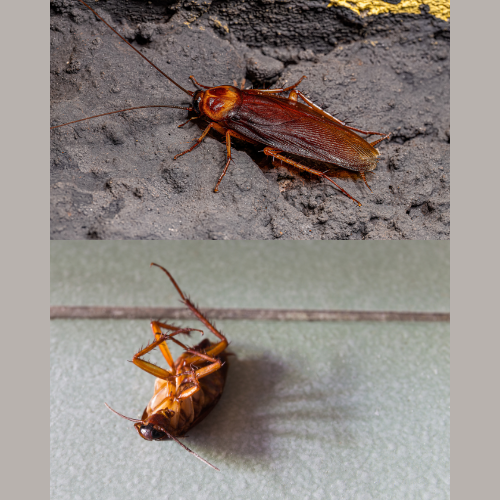
15 Dec Palmetto Bugs vs. Cockroaches
Differences and Similarities
In order to differentiate between palmetto bugs and cockroaches, it’s crucial to examine their physical characteristics. Palmetto bugs, a term commonly used in the southeastern United States, are often referring to the American cockroach. They are generally larger, exceeding 1.5 inches in length, with a reddish-brown coloration. In contrast, common cockroaches come in various species, such as the German and Oriental cockroaches, and are typically smaller, usually under an inch, with darker hues. Palmetto Bugs, a term often used in the southeastern United States, typically refer to the American cockroach. On the other hand, the term “Cockroaches” encompasses various species, like the German and Oriental cockroaches.
Reproduction, Diet and Behavior
Regarding reproduction, both species are prolific breeders. However, Palmetto Bugs lay larger egg cases, resulting in more offspring per cycle. Their preferred habitats also differ; Palmetto Bugs thrive in damp environments, often found outdoors, while cockroaches prefer indoor spaces, especially where food and moisture are readily available.
Both pests are omnivores, feeding on a variety of substances. Palmetto Bugs, however, are more likely to consume decaying matter. In terms of seasonality, cockroaches are commonly found year-round, especially in warm indoor environments. Palmetto Bugs are more prevalent in warmer months but can also persist through milder winters.
Cockroaches tend to be more invasive in homes due to their preference for indoor habitats. Identifying these pests involves looking at size, color, and behavior. Palmetto Bugs are larger and more likely to fly, while common cockroaches are smaller and more secretive.
Preventing Infestations
To prevent infestations, keep your home clean and free of food scraps. Seal cracks and crevices to deny entry, and reduce moisture through proper ventilation. Regularly inspect dark, damp areas where these pests may hide.
In the world of pest control, understanding the differences and similarities between palmetto bugs and cockroaches is essential. Recognizing their distinct characteristics, identifying common attractants, and seeking professional assistance can help you maintain a pest-free environment year-round. Don’t let these pests compromise the comfort and safety of your home or business; take action today for effective pest control. For more details visit www.pestbusterzz.com.
Fun Facts
Ancient Species: Cockroaches, including the American cockroach, have roamed the Earth for about 350 million years, predating the dinosaurs.
High Speed: Palmetto bugs impress with their speed, capable of sprinting at speeds of up to three miles per hour despite their size.
Survival Skills: American cockroaches showcase remarkable adaptability, enduring a wide range of environmental conditions, including extreme temperatures and even radiation.
Omnivorous Diet: Palmetto bugs are voracious scavengers, devouring a variety of substances, with a particular fondness for decaying organic matter, paper, cloth, and assorted food scraps.
Rapid Reproduction: These pests are prolific breeders, with a single female American cockroach able to produce up to 150 offspring during her lifetime.
Long Lifespan: American cockroaches boast relatively extended lifespans compared to many other insects, with a potential lifespan of up to two years.
Sensory Abilities: Palmetto bugs possess highly developed sensory organs, notably their antennae, which they rely on to detect chemicals in their environment, locate food, and find mates.
Light Aversion: American cockroaches are well-known for their aversion to light, preferring dark, concealed spaces, often scuttling away when exposed to light.
Predators and Prey: Although often deemed pests, American cockroaches play a role in the food chain, serving as prey for various animals, including birds, rodents, and some insects.


No Comments